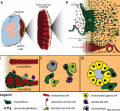File:Human trophoblast invasion 01.jpg: Difference between revisions
| Line 10: | Line 10: | ||
| valign=top width=300px| (iii) In addition, iCTBs invade and replace the epithelium of endometrial glands. | | valign=top width=300px| (iii) In addition, iCTBs invade and replace the epithelium of endometrial glands. | ||
|} | |} | ||
<br> | |||
AV, anchoring villus; CC, cell column; EVT, extravillous cytotrophoblast; eCTB, endovascular cytotrophoblast; iCTB, interstitial cytotrophoblast; SA, spiral artery; ST, syncytiotrophoblast; uNK, uterine natural killer cell. | AV, anchoring villus; CC, cell column; EVT, extravillous cytotrophoblast; eCTB, endovascular cytotrophoblast; iCTB, interstitial cytotrophoblast; SA, spiral artery; ST, syncytiotrophoblast; uNK, uterine natural killer cell. | ||
Revision as of 15:23, 24 January 2017
Human Trophoblast Invasion
| (A) The placenta connects the fetus to the uterine wall and establishes a vascular connection between mother and child. The placenta is structured as villous tree and is in direct contact with maternal blood and, thus referred to as hemochorial. The site where the placenta comes in direct contact with the maternal decidua is called the fetal-maternal interface. | (B) During early pregnancy, vCTBs fuse to form multinucleated STs, which surround the placental villus. STs transport nutrients and gases from the maternal to the fetal circulation and represent the major endocrine unit of the placenta by secreting hormones such as chorionic gonadotropin, placental growth hormone or placental lactogen. AV form cell columns that attach to the maternal decidua and give rise to the EVT lineage. Invasive EVTs can be divided into iCTBs, which invade the decidual stroma and become terminally differentiated multinucleated GCs, or eCTBs. |
| (i) The latter colonise the lumen of uterine spiral arteries and together with iCTBs, macrophages and uNK cells convert these vessels into larger conduits to guarantee adequate blood flow to the growing fetus. | (ii) Various decidual cell types such as macrophages, uNK cells and decidual stromal cells interact with the interstitial cytotrophoblasts in order to control iCTB invasion in an in a spatio-temporal manner. | (iii) In addition, iCTBs invade and replace the epithelium of endometrial glands. |
AV, anchoring villus; CC, cell column; EVT, extravillous cytotrophoblast; eCTB, endovascular cytotrophoblast; iCTB, interstitial cytotrophoblast; SA, spiral artery; ST, syncytiotrophoblast; uNK, uterine natural killer cell.
- Links: Trophoblast | Placenta Development
Reference
<pubmed>26418186</pubmed>
Copyright
© 2016 The Author(s). Published with license by Taylor & Francis Group, LLC© Philipp Velicky, Martin Knöfler, and Jürgen Pollheimer This is an Open Access article distributed under the terms of the Creative Commons Attribution License http://creativecommons.org/licenses/by/3.0/, which permits unrestricted use, distribution, and reproduction in any medium, provided the original work is properly cited. The moral rights of the named author(s) have been asserted.
Fig 1. Kcam_a_1089376_f0001_c.jpg http://www.tandfonline.com/na101/home/literatum/publisher/tandf/journals/content/kcam20/2016/kcam20.v010.i01-02/19336918.2015.1089376/20160808/images/large/kcam_a_1089376_f0001_c.jpeg
Cite this page: Hill, M.A. (2024, April 16) Embryology Human trophoblast invasion 01.jpg. Retrieved from https://embryology.med.unsw.edu.au/embryology/index.php/File:Human_trophoblast_invasion_01.jpg
- © Dr Mark Hill 2024, UNSW Embryology ISBN: 978 0 7334 2609 4 - UNSW CRICOS Provider Code No. 00098G
File history
Click on a date/time to view the file as it appeared at that time.
| Date/Time | Thumbnail | Dimensions | User | Comment | |
|---|---|---|---|---|---|
| current | 14:57, 24 January 2017 |  | 985 × 909 (223 KB) | Z8600021 (talk | contribs) | Kcam_a_1089376_f0001_c.jpg |
You cannot overwrite this file.
File usage
The following page uses this file: